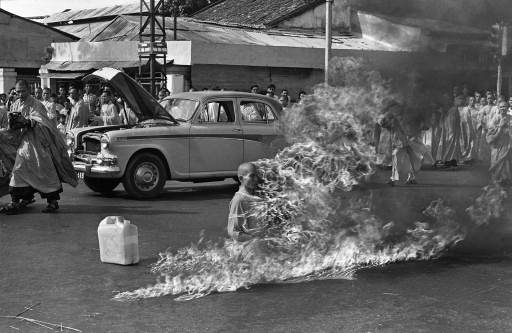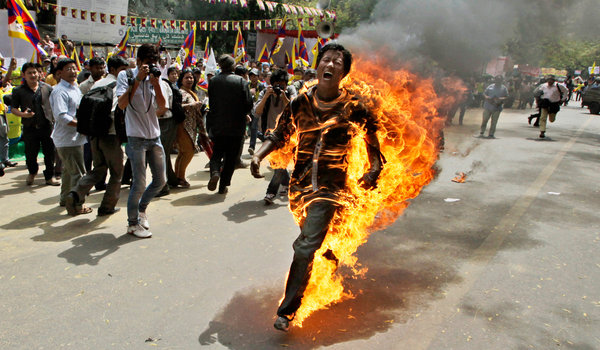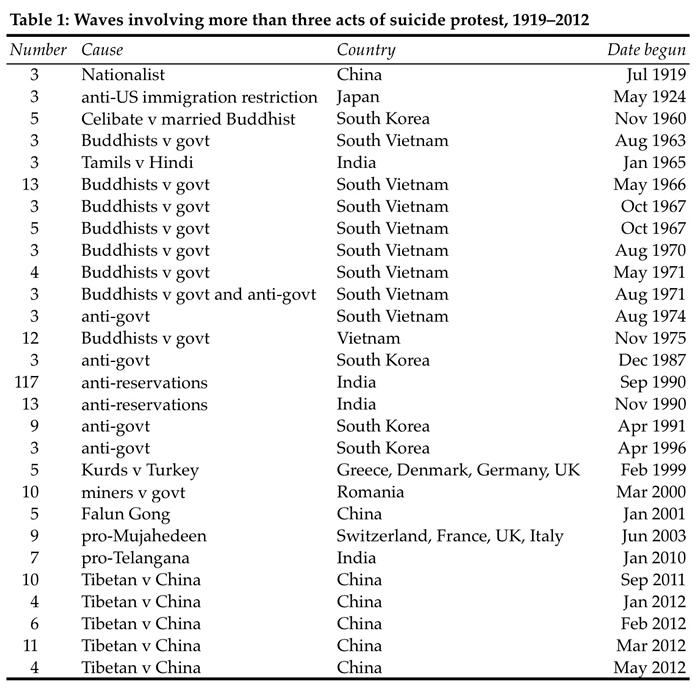Self-Immolation in Context, 1963-2012¹
Michael Biggs
Department of Sociology
University of Oxford
From March 2011 to June 2012, over three dozen Tibetans set themselves on fire to protest against repression in China. Self-immolation, though exceedingly rare, has been part of the global repertoire of protest for half a century. This article places the Tibetan cases within an international context of suicide protest over several decades. Comparison reveals the Tibetan episode to be one of the largest. It fits the general pattern of suicide protest being more prevalent in countries influenced by Indic (Buddhist, Hindu) rather than Semitic (Christian, Islamic) religious traditions. It departs from the general pattern of suicide protest being most prevalent in polities between the poles of autocracy and democracy. The most relevant episodes for comparison are Buddhists in South Vietnam in the 1960s and Falun Gong in China in the 2000s.
1. Numbers
I define ‘suicide protest’ (or equivalently, ‘self-immolation’) by criteria. First, an individual intentionally kills herself or himself, or at least inflicts physical injury likely to cause death.² Second, the act is not intended to harm anyone else or to cause material damage. Third, the act is ‘public’ in either of two senses: performed in a public place, or accompanied by a written declaration addressed to political figures or to the general public. Fourth, the act is committed for a collective cause rather than personal or familial grievances. These criteria serve to differentiate suicide protest from suicide terrorism, personal suicide, martyrdom, and cultic suicide. Note that suicide protest implies no particular method of self-killing. It does, however, exclude the hunger strike. Most hunger strikers do not make a commitment to die. Those who do, use the threat of death to bargain with the adversary. Suicide protest, by contrast, is unconditional; no bargaining is involved.
My data on suicide protest span the years 1919 to 2012, though collection is not yet complete for the last decade. The period 1919–1980 uses two newspapers: the New York Times and The Times of London. The digitized text is searched for keywords like ‘immolation’ and its variants, the combination of ‘suicide’ and ‘protest’, and so forth. The period 1977–2012 uses three newswires: Associated Press, Agence France Presse, and United Press International. A more limited search is undertaken on the keyword ‘immolation’ and its variants. These searches, along with extensive reading of secondary literature, yields information on 569 individuals who committed suicide protest. Deaths in prison are omitted because it is often impossible to distinguish protest suicide from ordinary suicide, death from natural causes, or murder by the authorities. Conceptually this exclusion has some justification because a prisoner—at least one who faces many years of incarceration—has less to live for.
The data I have collected cannot pretend to be comprehensive. For numerical comparison, therefore, it is more reliable to confine our attention to waves of protest, where multiple individuals commit suicide protest for the same collective cause, separated by intervals of less than ten days. Restricting attention to waves encompassing at least three individuals, Table 1 lists 28 waves, with a subtotal of 279 individuals.³ By far the largest wave occurred in India, when the government proposed to set aside more state jobs and university places for lower castes in 1990. In the campaign against this policy, over a hundred students set themselves on fire, took poison, or hanged themselves. The recent Tibetan episode provides five distinct waves—including one numbering 11 and another, 10—accounting for 13% of the subtotal.⁴ The Tibetan episode stands out still more prominently when we consider these numbers in relation to population. Tibetans in China number around 5–6 million (with about 150,000 in exile). This is far smaller than the populations represented in Table 1.⁵
To understand where suicide protest is more prevalent, we need to systematically examine all countries and years—including places where it has never happened. We also need to investigate several factors simultaneously. My analysis considers the country’s political system and religious heritage, controlling for population. Statistical analysis reveals that both have an effect. Political system is measured on a spectrum, with democracy at one end and autocracy at the other. Suicide protest is least likely at both ends of the spectrum, and most likely in the middle (e.g. South Vietnam in the 1960s or South Korea in the 1990s). The Tibetan episode diverges from this tendency, of course, because contemporary China is extremely autocratic. For religious heritage, suicide protest is less likely in countries with a Christian or Muslim religious heritage, compared to others. Differentiating this residual category by religion is problematic: which countries, for example, should be classified as Buddhist (what about Japan or South Korea)?⁶ An alternative is to examine the declared religion of individuals rather than their country’s heritage. Out of 569 individuals who committed suicide protest, almost three quarters had no apparent religious affiliation. About a quarter were Buddhists, almost entirely Tibetan and Vietnamese. Other religious traditions are represented in trifling numbers (six Christians, for example).
2. Comparison: Buddhists in South Vietnam
The common Buddhist environment and within it, the Mahāyanatradition—makes South Vietnam in the 1960s an appropriate comparison. In Saigon in 1963, an elderly monk called Thích Quảng Đửc set himself on fire to protest against religious persecution; the government of President Ngô Đình Diệm was dominated by Catholics. Quảng Đửc drew on ancient tradition.
 Thích Quảng Đức in the full photo of his self-immolation, during which he remained perfectly still. It was a Pulitzer Prize-winning photograph by Malcolm Browne.
Thích Quảng Đức in the full photo of his self-immolation, during which he remained perfectly still. It was a Pulitzer Prize-winning photograph by Malcolm Browne.Chinese Buddhist texts from the fourth century onwards describe monks choosing death—often but not always by fire—to manifest their transcendence of physical existence, to demonstrate the power of Buddhist practice, or to elicit benefits for their monastic community.⁷ Similar suicides by fire occurred in French Indochina in the 1920s and 1930s, after Quảng Đửc had entered monastic life. This ancient tradition was transformed into a contemporary media spectacle: American journalists were invited to watch the immolation, and indeed the assembled monks chanted slogans in English for their benefit.
Quảng Đửc’s sacrifice had a tremendous impact within South Vietnam. Suicide protest continued throughout the 1960s and 1970s, until the monasteries were completely suppressed after unification. Beyond Vietnam, the event introduced self-immolation into the global repertoire of protest. The photograph of Quảng Đửc seated in the lotus position, consumed by flames, was seen all around the world. Compared to the period 1919–1962, the annual rate of suicide protest was seventeen times higher in the period 1963–1970. Even excluding South Vietnam, the annual rate was eight times higher. Furthermore, suicide protest was now indelibly associated with burning. Suicide protests before 1963 had not used fire, but other means of death. Since 1963, 85% of individuals have chosen burning. The imprint of Quảng Đửc’s action endures.
The main similarity with Tibet is the link between Buddhism and national identity. In South Vietnam, Buddhism (like communism) was a vehicle for nationalism, defined first against French colonial rule and then against American domination. Monks obviously played a leading role in the struggle against religious persecution in 1963. The Buddhist movement subsequently came to oppose the government’s prosecution of the war against communist insurgency. The majority of immolators were monks, with a few nuns, rather than laypeople. The parallels with the recent episode in Tibet are clear. One difference is worth mentioning. Quảng Đửc and several other Vietnamese monks who set themselves alight had devoted many decades to monastic practice: they demonstrated almost superhuman self-control by sitting motionless while burning to death. The Tibetan monks, by contrast, are generally young, though Lama Sonam was in his forties. There have been no equivalent demonstrations of physical mastery, to my knowledge.
The differences with South Vietnam should also be noted. Most obviously, many of the immolations—like Quảng Đửc’s—were intended to address audiences in the United States as well as at home. This international appeal explains the extraordinary success in 1963: after nine suicide protests in five months, the Diệm government was overthrown. The coup was instigated by the United States. “We cannot stand any more burnings,” explained the Secretary of State.⁸ The causal connection was complex. The success of the Buddhist movement depended partly on the irrational reaction of Diệm, who began to disobey American orders; his successors were more careful. The United States viewed Diệm’s repression of the Buddhist movement as a distraction from fighting communism. In later years, as the Buddhist movement came to oppose the war itself, the United States treated it with hostility.
This complex political configuration has no direct parallel in the recent Tibetan episode. One might expect the immolations to appeal to international opinion, but the messages known to us are addressed to the Tibetan people. Jamphel Yeshe, who set himself on fire in Delhi in March 2012, is exceptional for also addressing a wider audience. “The fact that Tibetan people are setting themselves on fire in this 21st century is to let the world know about their suffering, and to tell the world about the denial of basic human rights.”⁹
 Jamphel Yeshe’s self-immolation, 26th March 2012
Jamphel Yeshe’s self-immolation, 26th March 2012Image: Manish Swarup / Associated Press
While the immolations attract sympathetic media coverage in the West, there is no leverage for Western states to exercise over China: its growing power is the very opposite of South Vietnam’s dependence. American domination also had a paradoxically beneficial effect on the Buddhist movement: repression was hindered by the presence of American journalists. When one journalist filmed a monk’s immolation, the police assaulted him and seized his camera—but the U.S. ambassador publicly criticized this attack on an American citizen.¹⁰ Moreover, American newspapers and magazines circulated freely within South Vietnam. Therefore the government of South Vietnam was unable to suppress information about suicide protest. Contemporary China, by contrast, has considerable control over information within its boundaries, albeit somewhat impeded by mobile telephones and internet connections. Certainly news can be censored from the majority Han Chinese public, who are unsympathetic to Tibetan claims.
3. Comparison: Falun Gong in China
Considering the Chinese state leads to another comparison: Falun Gong. This movement, based on the qigong healing tradition, was banned in 1999. In January 2001, on the eve of Chinese New Year, five followers set themselves alight in the Tiananmen Square and two more were thwarted. The government initially tried to suppress news of the event, even though Western journalists had witnessed the scene. Then it was realised how this could be turned against the movement. A week later, state television broadcast a gruesome film of the incident, including images of a 12-year-old girl (daughter of one of the practitioners) writhing in agony. The official leadership of Falun Gong, exiled in America, immediately denied any connection with the movement; it released its own video accusing the government of concocting the incident. While there is no reason to believe that the leadership sanctioned the suicides, it seems unnecessary to resort to any conspiracy theory. Some of the adults had taken part in previous protests. In addition, two more individuals set fire to themselves in the following months.
Self-immolation became the centre piece of the government’s continuing propaganda campaign. This framed the deaths as cultic suicide rather than political protest. “Nirvana means slaughter” was one headline in the People’s Daily.¹¹ By all accounts this had a major impact on Chinese public opinion. “Previously, most Chinese thought the crackdown [on Falun Gong] was stupid, like a dog catching a mouse,” admitted an anonymous official. “After those people burned themselves and the party broadcast that little girl’s face on TV for almost a month straight, people’s views here changed.”¹² Within weeks, the government ordered a massive increase in repression, including systematic torture. Not only was there a favourable climate of opinion; deaths in custody could now be used as evidence of the cult’s deleterious effects. The official news agency boasted that a total of 1,700 had committed suicide. The combination of torture, ‘re-education,’ and propaganda apparently yielded results. Within six months, Falun Gong was effectively eliminated as a movement within China. The maimed survivors were still being paraded before a press conference in the following year. “Falun Gong is indeed an evil cult and it led me to this,“ said one.¹³
The Chinese state seems to be attempting a similar response to the Tibetan immolations. Tapey was the first Tibetan in China to set himself on fire, in February 2009, and he survived. According to one report, he was brought on local television (in July 2011) to say that he regretted his action.¹⁴ After Lobsang Phuntsok’s immolation in March 2011, three monks (including an uncle of his) were charged with assisting his death. One accusation was that the immolation was planned in concert with Tibetans outside China. The evidence was that a photograph of Phuntsok was uploaded to Tibetans in exile, three days before he set himself alight, ready to be used for publicity after his death. A more serious accusation was that Phuntsok could have survived, if monks had allowed the security forces to take him to hospital; instead, they took the injured man back to their monastery. (In the Tibetan account, they rescued him from the security forces who were beating him after dousing the flames.) All three of the accused were convicted in August 2011, and sentenced to 10–13 years in prison. This incident is featured in China Central Television’s film (released in May 2012) entitled “The Dalai clique and self-immolation violent incidents.” Convicted monks are interviewed on camera, confessing to their involvement. Although the state is pursuing a similar media strategy, Falun Gong had two peculiar handicaps not found in the Tibetan episode. One was the leadership’s attempt to disassociate itself from the act. Another handicap was the involvement of children. Phuntsok was young—the state claims that he was 16, against 20 according to Tibetan sources—but was clearly old enough to exercise individual agency. One final difference is worth noting. The state portrayed Falun Gong as a religious cult. “Let me go to heaven,” cried one of the women in Tiananmen Square—according to the official news agency—as police prevented her from igniting herself.¹⁵ But the state does not claim that Tibetan immolations are intended to achieve religious transcendence.
Conclusion
Placing the Tibetan immolations in context may aid in understanding these terrible events. One sombre conclusion is that suicide protest, when it has attracted approbation from others, enters the repertoire of a political movement. The funerals of some of the Tibetan immolators have attracted hundreds or even thousands of mourners.¹⁶ Such numbers—in the face of repression by the authorities—demonstrate the depth of popular approval. Self-immolation therefore becomes a model to be followed. When Lama Sobha set fire to himself in January 2012, he left a tape recording expressing gratitude to “other Tibetan heroes, who have sacrificed their lives for Tibet.” His sacrifice in part was intended “to stand in solidarity with them in flesh and blood.”¹⁷ We can only expect further immolations for the cause of Tibet.
Notes
¹ My thanks are due to Katia Buffetrille, Françoise Robin, and the other participants in the workshop.
² An earlier essay included thwarted acts of suicide protest, when people doused themselves flammable liquid but were physically prevented from ignition by police or their own supporters. I now think such cases should be excluded, because they suggest theatrical performance more than genuine attempt at self-harm. The essay is “Dying without Killing: Self-Immolations, 1963-2002,” in Diego Gambetta (ed.), Making Sense of Suicide Missions. Oxford: Oxford University Press, 2005.
³ Information is still lacking on recent episodes of suicide protest in India for the Telangana cause, and in North-Africa in 2011.
⁴ See Katia Buffetrille’s article in this issue.
⁵ The population of Turkish Kurds is even smaller if we consider only those in Europe, numbering about one million; Olivier Grojean, La cause kurde, de la Turquie vers l’Europe: contribution à une sociologie de la transnationalisation des mobilizations, PhD thesis, École des Hautes Études en Sciences Sociales, 2008. But counting those in Turkey brings the figure to perhaps 15 million. See Olivier Grojean’s article in this issue.
⁶ ‘To ask a census-taker how many Chinese are Buddhist is rather like asking how many Westerners are Aristotelian or pragmatist’. See Wilfred Cantwell Smith, The Meaning and End of Religion. San Francisco: Harper and Row, 1962, p. 69.
⁷ James A. Benn, Burning for the Buddha: Self-immolation in Chinese Buddhism. Honolulu: University of Hawai’i Press, 2007. Also see James Benn’s article in this issue.
⁸ Howard Jones, Death of a Generation: How the Assassinations of Diem and JFK Prolonged the Vietnam War. Oxford: Oxford University Press, 2003, p. 317.
⁹ Associated Press, March 29 2012.
¹⁰ New York Times, October 6 1963, p. 20.
¹¹ Agence France Presse, February 17 2001.
¹² Washington Post, August 5 2001.
¹³ Xinhua News Agency, April 7 2002.
¹⁴ This was reported by http://www.freetibet.org/newsmedia/selfimmolations. Tapey certainly features in recent Chinese propaganda, as the beneficiary of expensive medical care: Xinhua News, June 22 2012.
¹⁵ Associated Press, January 30 2001.
¹⁶ E.g. Associated Press, March 18 2012.
¹⁷ Transcript translated by Students for a Free Tibet together with Bhuchung D. Sonam, accessed from http://www.savetibet.org/media-center/ict-news-reports/harrowing-images-and-last-message-tibet-first-lama-self-immolate, May 21 2012.
Table 1



